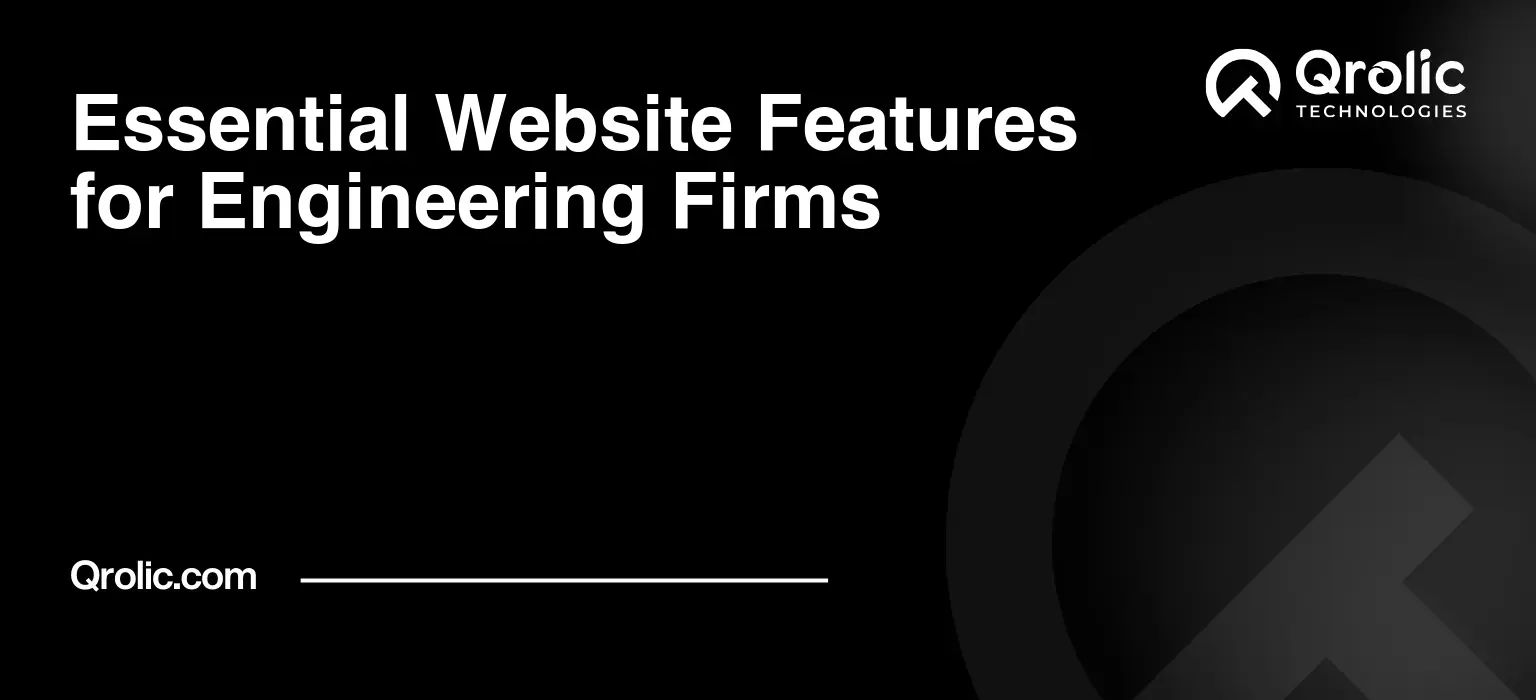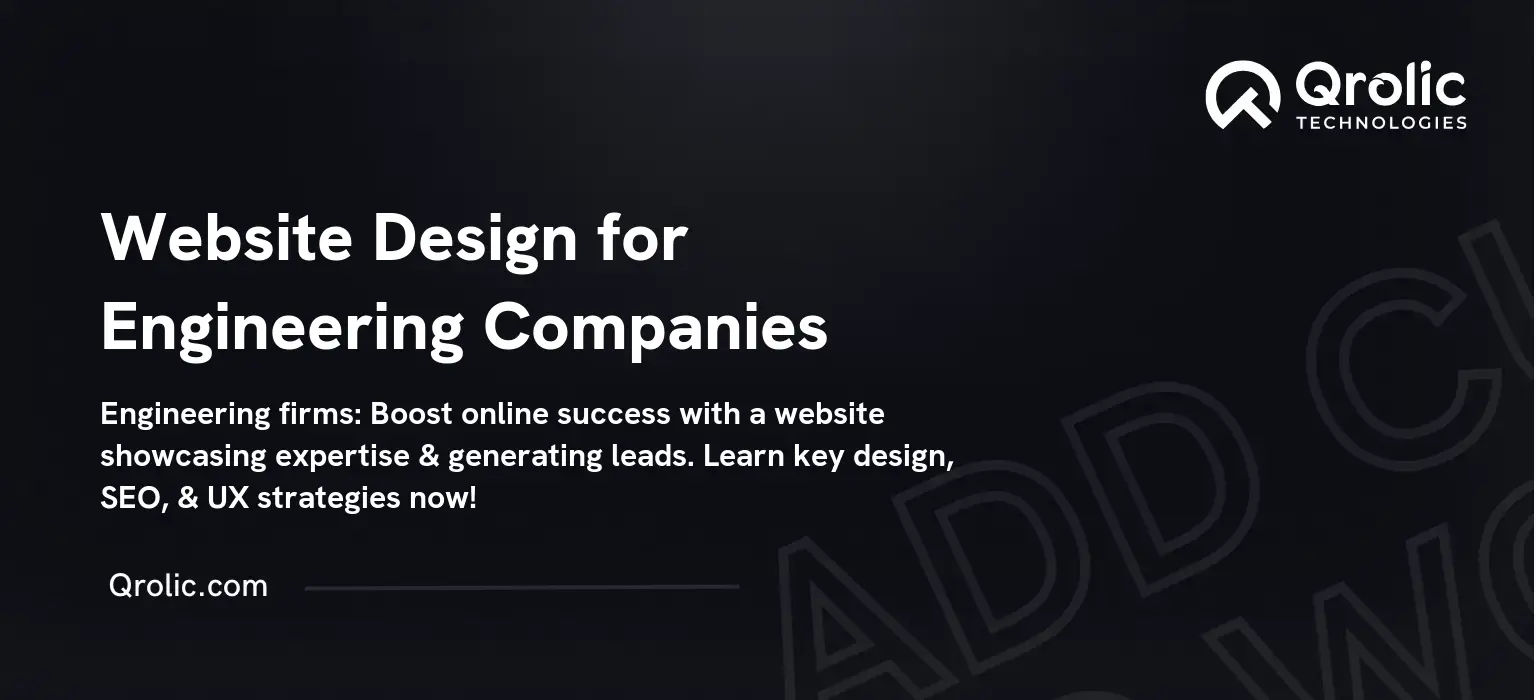Quick Summary:
- Feature clear services, impactful case studies, and easy contact.
- Optimize your website for search engines to be found.
- Showcase expertise with high-quality visuals and valuable content.
- Regularly update and maintain your site for success.
Table of Contents
- The Foundation: Why a Robust Website is Non-Negotiable for Engineering Firms
- The ROI of a Well-Designed Engineering Firm Website
- Core Website Sections: Building a User-Centric Experience
- 1. Homepage: First Impressions Matter
- 2. Services Overview: Showcasing Your Expertise
- 3. Case Studies: Demonstrating Success
- 4. About Us: Building Trust and Connection
- 5. Contact Us: Making it Easy to Connect
- Technical SEO and Website Optimization: Ensuring Visibility
- 1. Keyword Research: Understanding Search Intent
- 2. On-Page Optimization: Making Your Website Search Engine Friendly
- 3. Off-Page Optimization: Building Authority and Trust
- 4. Technical Website Audit
- Content Marketing: Establishing Thought Leadership
- 1. Blog Posts: Sharing Expertise and Insights
- 2. White Papers and eBooks: In-Depth Resources
- 3. Videos: Engaging Visual Content
- 4. Webinars: Interactive Learning Experiences
- Essential Website Features: Beyond the Basics
- 1. Project Portfolio: Visualizing Success
- 2. Online Calculator Tools
- 3. Client Portal
- 4. Live Chat Support
- 5. Multi-Language Support
- Qrolic Technologies: Your Partner in Building a Powerful Engineering Firm Website
- Measuring Success: Website Analytics and Reporting
- 1. Key Performance Indicators (KPIs)
- 2. Google Analytics
- 3. Regular Reporting
- Staying Ahead: Ongoing Website Maintenance and Updates
- 1. Security Updates
- 2. Content Updates
- 3. Technical Maintenance
- 4. Design Updates
The Foundation: Why a Robust Website is Non-Negotiable for Engineering Firms
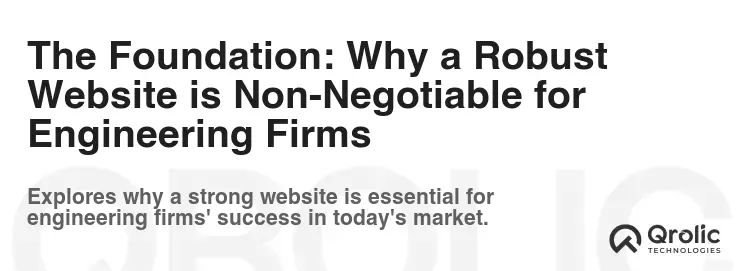
In today’s digital landscape, an engineering firm website is more than just an online brochure; it’s a crucial tool for business development, client acquisition, and brand building. Think of it as your 24/7 representative, constantly showcasing your expertise and driving leads. But merely having a website isn’t enough. It needs to be strategically designed with essential features that cater specifically to the needs of potential clients seeking engineering solutions. Without a strong online presence, you’re essentially invisible to a significant portion of your target market.
The ROI of a Well-Designed Engineering Firm Website
- Increased Lead Generation: A well-optimized website acts as a lead magnet, attracting potential clients actively searching for engineering services.
- Enhanced Credibility: A professional and informative website instills trust and confidence in your firm’s capabilities.
- Improved Brand Awareness: Consistent branding across your website reinforces your firm’s identity and values.
- Expanded Market Reach: A website allows you to reach clients beyond your geographical limitations.
- Streamlined Communication: Provides a central hub for information, reducing the burden on your team for answering basic inquiries.
- Competitive Advantage: A superior website can differentiate you from competitors in a crowded market.
- Cost-Effective Marketing: Compared to traditional marketing methods, a website offers a cost-effective way to reach a broad audience.
- Data-Driven Insights: Website analytics provide valuable data on user behavior, allowing you to refine your marketing strategies.
Core Website Sections: Building a User-Centric Experience
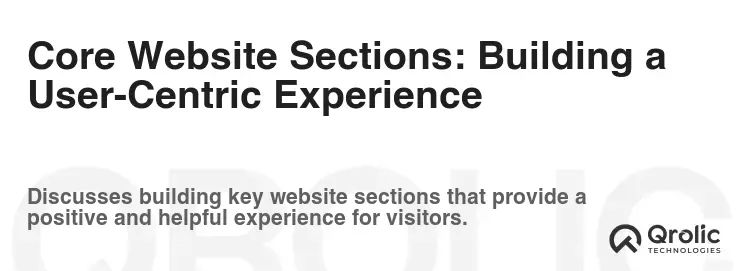
The success of your engineering firm website hinges on its ability to provide a seamless and informative experience for visitors. Key sections must be thoughtfully designed and populated with relevant content.
1. Homepage: First Impressions Matter
The homepage is your digital storefront. It needs to immediately capture attention and convey your firm’s core value proposition.
- Clear Value Proposition: Immediately communicate what makes your firm unique and the specific problems you solve. Use concise and compelling language. Example: “Providing Innovative and Sustainable Engineering Solutions for a Better Tomorrow.”
- High-Quality Visuals: Utilize professional photography and videos that showcase your projects and expertise. Avoid generic stock photos. Example: Showcase a recent project completion with drone footage and compelling before-and-after shots.
- Compelling Call-to-Actions (CTAs): Guide visitors towards desired actions, such as requesting a consultation, downloading a brochure, or viewing case studies. Use action-oriented language. Examples: “Get a Free Consultation,” “Download Our Project Portfolio,” “Explore Our Expertise.”
- Easy Navigation: Ensure a clear and intuitive navigation menu that allows visitors to quickly find the information they need.
- Mobile Responsiveness: Ensure the homepage and entire website display flawlessly on all devices (desktops, tablets, and smartphones).
- Fast Loading Speed: Optimize images and code to ensure a fast loading time. A slow website can deter visitors.
- Latest News/Blog Snippets: Showcase recent accomplishments, industry insights, or company updates to keep the content fresh.
- Client Testimonials (Strategic Placement): Include short, impactful testimonials near key sections to build trust and credibility.
2. Services Overview: Showcasing Your Expertise
The services overview section is where you detail the range of engineering disciplines and services your firm offers. This is a critical area for attracting clients with specific needs.
- Comprehensive List of Services: Clearly list all the services you provide, organized by discipline (e.g., structural engineering, mechanical engineering, environmental engineering).
- Detailed Service Descriptions: For each service, provide a comprehensive description that outlines the scope, process, and benefits. Use clear and concise language, avoiding technical jargon. Example: “Structural Engineering: We provide comprehensive structural design and analysis services for buildings, bridges, and other infrastructure projects. Our team utilizes advanced software and techniques to ensure structural integrity and safety.”
- Target Specific Keywords: Optimize service descriptions with relevant keywords that potential clients are likely to search for. Example: “Seismic Design,” “Bridge Inspection,” “LEED Certification.”
- Visual Aids: Supplement service descriptions with images, diagrams, or videos that illustrate the process or outcome.
- Call-to-Action within Each Service: Include a clear call-to-action within each service description, such as “Request a Quote” or “Learn More.”
- Highlight Unique Selling Propositions (USPs): Emphasize what sets your firm apart in each service area. Example: “Our team specializes in sustainable design practices, minimizing environmental impact and maximizing energy efficiency.”
- Project Examples: Briefly mention relevant projects related to each service to provide concrete examples of your capabilities. Link to full case studies if available.
3. Case Studies: Demonstrating Success
Case studies are arguably the most powerful tool on your engineering firm website. They provide tangible proof of your capabilities and demonstrate the positive impact you’ve had on past clients.
- In-Depth Project Descriptions: Provide detailed accounts of each project, including the challenge, your solution, and the results achieved.
- Quantifiable Results: Whenever possible, quantify the results of your work using metrics and data. Example: “Reduced energy consumption by 30%,” “Increased production capacity by 15%,” “Saved the client $500,000 in construction costs.”
- High-Quality Visuals (Before & After): Include high-quality photographs and videos that showcase the project before, during, and after completion. Drone footage is particularly effective.
- Client Testimonials (Within Case Study): Integrate client testimonials directly into the case study to provide third-party validation.
- Focus on Specific Disciplines: Categorize case studies by engineering discipline to allow visitors to easily find relevant examples.
- Target Specific Industries: Further categorize case studies by industry to demonstrate your experience in specific sectors (e.g., healthcare, education, manufacturing).
- Detailed Problem/Solution Narrative: Clearly articulate the client’s initial problem and how your firm’s expertise provided the ideal solution.
- PDF Downloads (Optional): Offer a downloadable PDF version of each case study for visitors to save and share.
- SEO Optimization: Optimize each case study page with relevant keywords that potential clients are likely to search for.
- Call-to-Action (End of Case Study): Conclude each case study with a clear call-to-action, such as “Contact Us to Discuss Your Project” or “View Similar Projects.”
4. About Us: Building Trust and Connection
The “About Us” section is your opportunity to humanize your firm and build trust with potential clients.
- Firm History and Mission: Share your firm’s history, mission, and values. Highlight what makes your firm unique and your commitment to excellence.
- Team Bios and Expertise: Introduce your team members and highlight their qualifications, experience, and areas of expertise. Include professional photos.
- Company Culture: Showcase your company culture to attract both clients and potential employees. This could include photos of team events, community involvement, or employee testimonials.
- Awards and Recognition: Highlight any awards, certifications, or recognition your firm has received.
- Partnerships and Affiliations: List any relevant partnerships or affiliations with industry organizations.
- Commitment to Sustainability (If Applicable): If your firm is committed to sustainable practices, highlight your efforts and certifications.
- Clear Contact Information: Provide clear and easily accessible contact information, including phone number, email address, and physical address.
- Visual Appeal: Use high-quality images and videos to enhance the visual appeal of the “About Us” section.
- Tell a Story: Instead of simply listing facts, tell a compelling story about your firm’s journey and accomplishments.
- Avoid Jargon: Use clear and concise language that is easy for potential clients to understand.
5. Contact Us: Making it Easy to Connect
The “Contact Us” section should be prominent and easy to find on every page of your engineering firm website.
- Contact Form: Include a user-friendly contact form that allows visitors to easily submit inquiries.
- Phone Number: Display your phone number prominently and make it clickable on mobile devices.
- Email Address: Provide a direct email address for inquiries.
- Physical Address: Include your physical address and a map for easy navigation.
- Social Media Links: Include links to your social media profiles (LinkedIn, Facebook, Twitter).
- Multiple Contact Options: Offer multiple ways for visitors to connect (e.g., phone, email, contact form, live chat).
- Fast Response Time Promise: Communicate your commitment to responding to inquiries promptly.
- Security Measures: Assure users that their information submitted through the contact form is secure.
- Thank You Page: Redirect users to a thank you page after submitting the contact form to confirm receipt and set expectations for response time.
- Spam Protection: Implement measures to prevent spam submissions through the contact form.
Technical SEO and Website Optimization: Ensuring Visibility

Even the most beautifully designed website is useless if it can’t be found by potential clients. Engineering firm website SEO is crucial for driving organic traffic from search engines.
1. Keyword Research: Understanding Search Intent
- Identify Target Keywords: Conduct thorough keyword research to identify the terms potential clients are using to search for engineering services. Examples: “structural engineering firms near me,” “civil engineering consultants,” “mechanical engineering design.”
- Long-Tail Keywords: Focus on long-tail keywords, which are longer and more specific phrases that often have lower competition. Example: “sustainable building design services in San Francisco.”
- Competitor Analysis: Analyze your competitors’ websites to identify the keywords they are targeting.
- Keyword Mapping: Map your target keywords to specific pages on your website to ensure relevance.
- Use Keyword Research Tools: Utilize tools like Google Keyword Planner, SEMrush, and Ahrefs to identify relevant keywords and analyze search volume.
2. On-Page Optimization: Making Your Website Search Engine Friendly
- Title Tags: Optimize title tags with relevant keywords. The title tag is the first thing search engines see and is a critical ranking factor.
- Meta Descriptions: Write compelling meta descriptions that entice users to click on your website in search results.
- Header Tags (H1-H6): Use header tags to structure your content and highlight important keywords.
- Image Alt Text: Provide descriptive alt text for all images on your website. This helps search engines understand the content of the images and improves accessibility.
- Content Optimization: Write high-quality, informative, and engaging content that is optimized for your target keywords.
- Internal Linking: Link to other relevant pages on your website to improve navigation and distribute link equity.
- URL Structure: Use clear and concise URLs that include relevant keywords.
- Schema Markup: Implement schema markup to provide search engines with more information about your website and content. This can improve your website’s visibility in search results.
3. Off-Page Optimization: Building Authority and Trust
- Link Building: Acquire high-quality backlinks from other reputable websites in your industry.
- Directory Submissions: Submit your website to relevant online directories.
- Social Media Marketing: Promote your website and content on social media platforms.
- Online Reputation Management: Monitor and manage your online reputation to ensure a positive brand image.
- Guest Blogging: Contribute guest posts to other websites in your industry to build brand awareness and earn backlinks.
- Local SEO: Optimize your website for local search to attract clients in your area. This includes claiming your Google My Business listing and optimizing your website for local keywords.
4. Technical Website Audit
Regularly conduct technical audits to identify and fix any issues that may be hindering your website’s performance.
- Mobile-Friendliness: Ensure your website is fully responsive and provides a seamless experience on all devices.
- Page Speed Optimization: Optimize your website’s loading speed by compressing images, minimizing code, and leveraging browser caching.
- Broken Link Analysis: Identify and fix any broken links on your website.
- Crawlability and Indexability: Ensure search engines can easily crawl and index your website.
- Sitemap Submission: Submit a sitemap to search engines to help them discover and index your website’s pages.
- SSL Certificate: Install an SSL certificate to secure your website and protect user data.
- Core Web Vitals: Monitor and optimize your website’s Core Web Vitals, which are a set of metrics that measure user experience.
Content Marketing: Establishing Thought Leadership

Content marketing is an essential strategy for attracting and engaging potential clients. By creating valuable and informative content, you can establish your firm as a thought leader in the engineering industry.
1. Blog Posts: Sharing Expertise and Insights
- Industry Trends: Write blog posts about current trends in the engineering industry. Example: “The Future of Sustainable Infrastructure Development.”
- Technical Articles: Share your expertise on technical topics relevant to your target audience. Example: “A Deep Dive into Finite Element Analysis for Structural Design.”
- Project Updates: Provide updates on your latest projects, highlighting the challenges and solutions.
- Case Study Summaries: Summarize your case studies into blog posts to reach a wider audience.
- Best Practices and Tips: Share best practices and tips for various engineering disciplines. Example: “5 Tips for Designing Energy-Efficient Buildings.”
- Behind-the-Scenes Content: Offer a glimpse into your firm’s operations and company culture.
- Keyword Optimization: Optimize each blog post with relevant keywords.
- Call-to-Action: Include a clear call-to-action at the end of each blog post, such as “Contact Us for a Consultation” or “Download Our Free Guide.”
- Promote on Social Media: Share your blog posts on social media to reach a wider audience.
2. White Papers and eBooks: In-Depth Resources
- Comprehensive Guides: Create comprehensive guides on specific engineering topics.
- Research Reports: Publish research reports on emerging technologies and trends.
- Industry Analysis: Provide in-depth analysis of specific industries and their engineering needs.
- Downloadable Resources: Offer downloadable white papers and eBooks as lead magnets to capture contact information.
- Promote Through Email Marketing: Promote your white papers and eBooks through email marketing campaigns.
3. Videos: Engaging Visual Content
- Project Showcases: Create videos that showcase your projects and highlight the results achieved.
- Expert Interviews: Interview your team members and other industry experts to share their insights.
- Educational Tutorials: Create educational tutorials on various engineering topics.
- Company Culture Videos: Showcase your company culture to attract potential employees.
- Optimize for YouTube: Optimize your videos for YouTube search to reach a wider audience.
- Embed on Your Website: Embed your videos on your website to enhance engagement.
4. Webinars: Interactive Learning Experiences
- Live Presentations: Host live webinars on relevant engineering topics.
- Q&A Sessions: Include Q&A sessions to engage with your audience and answer their questions.
- Record and Share: Record your webinars and share them on your website and social media platforms.
- Promote Through Email Marketing: Promote your webinars through email marketing campaigns.
- Collect Leads: Use webinars as a lead generation tool by requiring registration.
Essential Website Features: Beyond the Basics
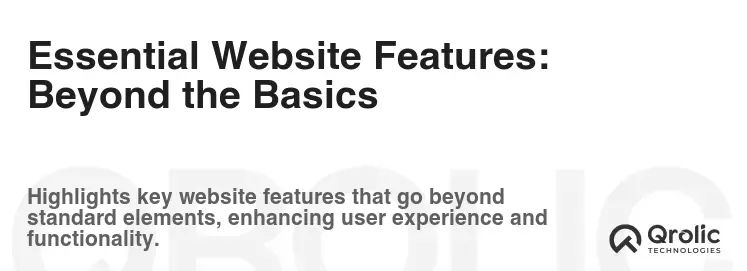
While the core sections and SEO strategies outlined above are essential, there are additional features that can significantly enhance the user experience and improve your website’s performance.
1. Project Portfolio: Visualizing Success
A well-organized and visually appealing project portfolio is crucial for showcasing your firm’s capabilities and attracting potential clients.
- High-Quality Images and Videos: Use high-quality images and videos to showcase your projects.
- Detailed Project Descriptions: Provide detailed descriptions of each project, including the challenges, solutions, and results achieved.
- Categorization and Filtering: Allow visitors to easily filter projects by discipline, industry, and location.
- Interactive Maps: Integrate interactive maps to showcase the geographic distribution of your projects.
- Client Testimonials: Include client testimonials for each project to provide third-party validation.
- Call-to-Action: Include a clear call-to-action on each project page, such as “Contact Us to Discuss Your Project.”
2. Online Calculator Tools
- Relevant Calculation Tools: Offer free online calculation tools that are relevant to your target audience. Example: “Beam Load Calculator,” “HVAC System Design Calculator.”
- Lead Generation: Require users to provide their contact information to access the calculator tools.
- Value Proposition: Clearly communicate the value and benefits of using the calculator tools.
3. Client Portal
- Secure Access: Provide clients with secure access to project documents, updates, and communication tools.
- Streamlined Communication: Facilitate seamless communication between your team and clients.
- Enhanced Transparency: Improve transparency and build trust with clients.
4. Live Chat Support
- Instant Assistance: Provide instant assistance to website visitors through live chat.
- Lead Qualification: Use live chat to qualify leads and gather contact information.
- Improved Customer Satisfaction: Enhance customer satisfaction by providing quick and helpful support.
5. Multi-Language Support
- Expanded Reach: Expand your reach to a global audience by offering your website in multiple languages.
- Improved User Experience: Provide a better user experience for visitors who speak different languages.
Qrolic Technologies: Your Partner in Building a Powerful Engineering Firm Website
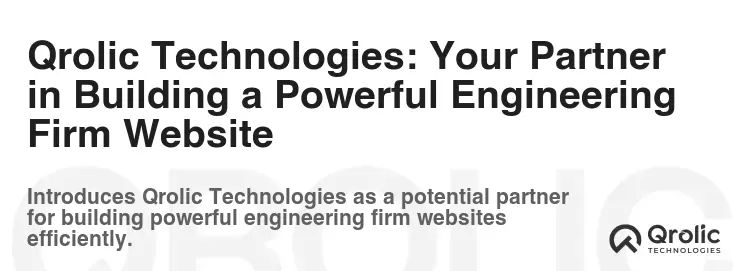
Qrolic Technologies (https://qrolic.com/) understands the unique challenges and opportunities faced by engineering firms in the digital age. We specialize in developing custom website solutions that are tailored to the specific needs of the engineering industry. Our team of experienced designers, developers, and SEO experts can help you build a website that:
- Attracts qualified leads: We implement proven SEO strategies to ensure your website ranks high in search results, driving organic traffic from potential clients actively searching for engineering services.
- Showcases your expertise: We create visually stunning and informative case studies that demonstrate your firm’s capabilities and highlight your successes. Our focus is to showcase the impact that your firm has had on the project.
- Builds trust and credibility: We design websites that are professional, informative, and user-friendly, instilling trust and confidence in your firm’s expertise.
- Drives business growth: Our websites are designed to convert visitors into leads and ultimately drive business growth for your engineering firm.
- Responsive Design & Seamless User Experience: We build mobile-first, responsive websites so clients and prospects can easily find and engage with your firm on any device
- Content Management Systems (CMS): We use robust CMS platforms that make it easy for you to update and manage your website content.
- Data-Driven Approach: We use advanced analytics to track website performance and identify areas for improvement.
Qrolic Technologies offers a comprehensive suite of website development and digital marketing services, including:
- Website Design and Development: Custom website design and development tailored to the specific needs of engineering firms.
- SEO Optimization: Comprehensive SEO strategies to improve your website’s visibility in search results.
- Content Marketing: Creation of high-quality, informative content that attracts and engages potential clients.
- Social Media Marketing: Social media marketing strategies to build brand awareness and generate leads.
- Pay-Per-Click (PPC) Advertising: Targeted PPC advertising campaigns to drive traffic to your website.
- Website Maintenance and Support: Ongoing website maintenance and support to ensure your website is always up-to-date and performing optimally.
Contact Qrolic Technologies today to learn how we can help you build a powerful website that drives business growth for your engineering firm.
Measuring Success: Website Analytics and Reporting
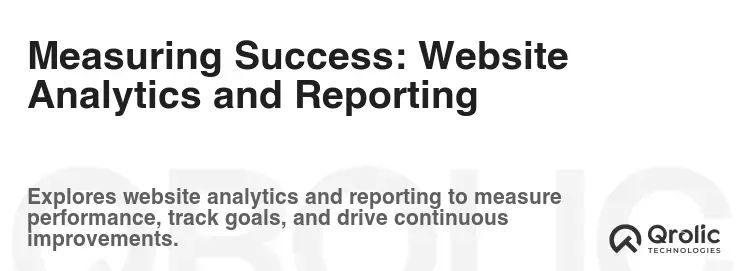
Once your website is live, it’s crucial to track its performance and identify areas for improvement. Website analytics provide valuable data on user behavior, allowing you to refine your marketing strategies and optimize your website for better results.
1. Key Performance Indicators (KPIs)
- Website Traffic: Track the number of visitors to your website.
- Bounce Rate: Monitor the percentage of visitors who leave your website after viewing only one page.
- Time on Page: Measure the average amount of time visitors spend on each page of your website.
- Conversion Rate: Track the percentage of visitors who complete a desired action, such as submitting a contact form or downloading a brochure.
- Lead Generation: Monitor the number of leads generated through your website.
- Cost Per Lead: Calculate the cost of acquiring each lead through your website.
- Return on Investment (ROI): Measure the ROI of your website by comparing the cost of development and maintenance to the revenue generated.
2. Google Analytics
- Free and Powerful Tool: Google Analytics is a free and powerful tool for tracking website traffic and user behavior.
- Detailed Reports: Google Analytics provides detailed reports on various aspects of your website’s performance.
- Custom Dashboards: Create custom dashboards to track the KPIs that are most important to your business.
3. Regular Reporting
- Monthly Reports: Generate monthly reports to track your website’s performance over time.
- Identify Trends: Analyze your website’s performance to identify trends and patterns.
- Make Data-Driven Decisions: Use data to make informed decisions about your website’s design, content, and marketing strategies.
Staying Ahead: Ongoing Website Maintenance and Updates
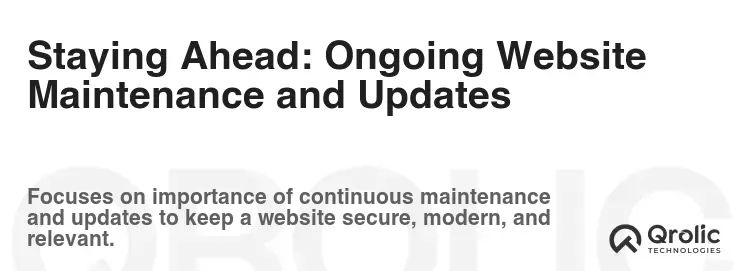
Your website is not a one-time project; it requires ongoing maintenance and updates to ensure it remains relevant, secure, and effective.
1. Security Updates
- Regular Security Updates: Install regular security updates to protect your website from vulnerabilities and cyber threats.
- SSL Certificate Renewal: Ensure your SSL certificate is always up-to-date.
2. Content Updates
- Keep Content Fresh: Regularly update your website content to keep it fresh and relevant.
- Add New Case Studies: Add new case studies to showcase your latest projects.
- Blog Regularly: Publish new blog posts on a regular basis to attract and engage potential clients.
3. Technical Maintenance
- Broken Link Checks: Regularly check for and fix any broken links on your website.
- Page Speed Optimization: Continuously optimize your website’s loading speed.
- Mobile-Friendliness Testing: Regularly test your website’s mobile-friendliness to ensure a seamless user experience.
4. Design Updates
- Stay Up-to-Date: Keep your website design up-to-date with the latest trends and technologies.
- Improve User Experience: Continuously improve your website’s user experience based on user feedback and analytics data.
By implementing these essential website features and following these best practices, you can create a powerful online presence that attracts potential clients, showcases your expertise, and drives business growth for your engineering firm. The engineering firm website, with a compelling services overview and impactful case studies, becomes your most valuable marketing asset.
